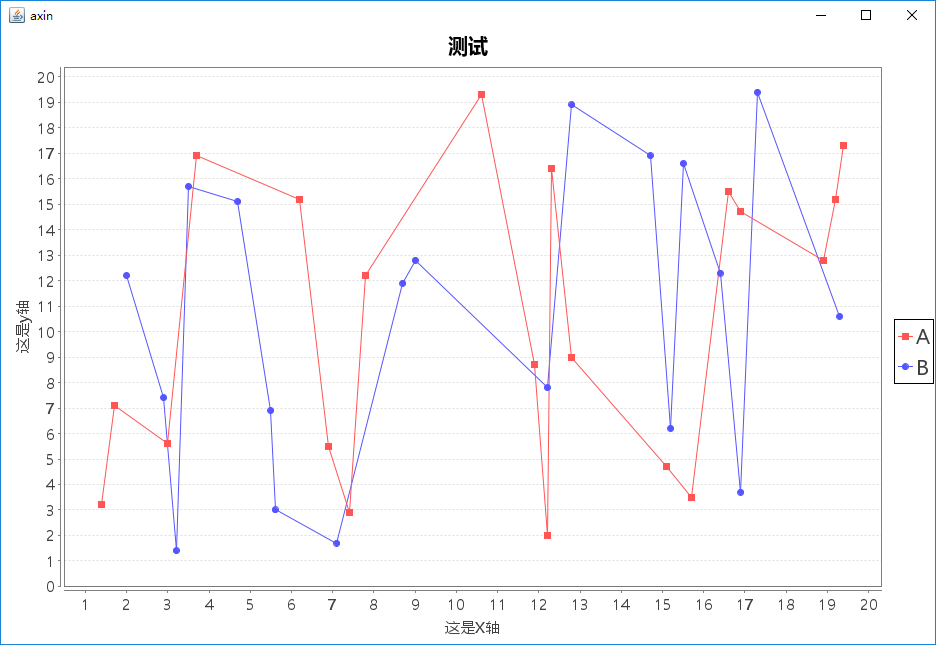使用JFreeChart繪制XY折線圖(工具類設計)
阿新 • • 發佈:2018-10-17
rtp 折線 int super 單元 sco cat 接口 後端
準備用Java寫通信的仿真平臺作為畢業設計,相比matlab繪圖,Java繪圖需要自己去寫很多工具類,博主在這采用了JFreeChart的開源解決方案,摸索著自己寫了一個XY折線圖工具類,話不多說貼源碼,源碼中寫了很多註釋,配了一套自己用的繪圖樣式,需要的童鞋可以借鑒借鑒,希望對你有幫助。源代碼已上傳我的github上。
首先用Maven引入Jar包
<!-- Java 繪圖 --> <dependency> <groupId>jfree</groupId> <artifactId>jfreechart</artifactId> <version>1.0.13</version> </dependency>
DrawingToolsTest工具類設計
先看效果
下方是我的測試方法,準備了x和y的數據放入Map中,然後傳入已經寫好的接口中,就一行代碼。底層的過程都封裝好了,調的話很方便
public class DrawingToolsTest { @Test public void testTools() { int sum = 20;//隨機生成20對數 Map<Double, Double> map1 = new HashMap<>(); double[] restX = RandomTools.getRadomDouble(1, 20, 1, sum); double[] restY = RandomTools.getRadomDouble(1, 20, 1, sum); for (int i = 0; i < sum; i++) { map1.put(restX[i], restY[i]); } Map<Double, Double> map2 = new HashMap<>(); for (int i = 0; i < sum; i++) { map2.put(restY[i], restX[i]); } Map<Double, Double>[] dataSet = new Map[]{map1, map2}; String[] types = new String[]{"A", "B"}; //調用繪圖工具 DrawingTools.drawLineChart("axin", "測試", "這是X軸", "這是y軸", dataSet, types); Scanner in = new Scanner(System.in); in.hasNext(); } } /** * @author Axin */ public class RandomTools { /** * @param start * @param end * @param retain 保留幾位小數 * @param sum 生成多少個數 * @return */ public static double[] getRadomDouble(int start, int end, int retain, int sum) { double[] res = new double[sum]; for (int i = 0; i < sum; i++) { BigDecimal db = new BigDecimal(Math.random() * (end - start) + start); //四舍五入 res[i] = db.setScale(retain, BigDecimal.ROUND_HALF_UP).doubleValue(); } return res; } }
運行後:

工具類源碼
/** * 後端繪圖類 * * @author Axin * @date 2018-10-16 */ @ConfigurationProperties(prefix = "draw") public class DrawingTools extends ApplicationFrame { private String titleFont; private int titleFontSize; private String xyFont; private int xyFontSize; DrawingTools() { this("Axin"); } public DrawingTools(String appTitle) { super(appTitle); this.titleFont = "微軟雅黑"; this.titleFontSize = 20; this.xyFont = "微軟雅黑"; this.xyFontSize = 15; } /** * @param appTitle 標題 * @param chartTitle 圖標題 * @param xName x軸命名 * @param yName y軸命名 * @param dataSet 數據集 * @param types 線條種類 */ public static void drawLineChart(String appTitle, String chartTitle, String xName, String yName, Map<Double, Double>[] dataSet, String[] types) { DrawingTools tools = new DrawingTools(appTitle); IntervalXYDataset dataset = tools.getLineDataset(dataSet, types); JFreeChart chart = tools.getLineChart(chartTitle, xName, yName, dataset); //繪圖模式化 tools.setChartCSS(chart); ChartPanel chartPanel = new ChartPanel(chart); chartPanel.setPreferredSize(new java.awt.Dimension(900, 600)); tools.setContentPane(chartPanel); tools.pack(); RefineryUtilities.centerFrameOnScreen(tools); tools.setVisible(true); } private JFreeChart getLineChart(String title, String xName, String yName, XYDataset dataset) { /** * 圖標標題,x軸名稱,y軸名稱,數據集合,圖標顯示方向,是否使用圖示,是否生成工具欄,是否生成URL鏈接 */ JFreeChart chart = ChartFactory.createXYLineChart( title, xName, yName, dataset, PlotOrientation.VERTICAL, true, true, false ); return chart; } /** * 自定義設置圖表字體樣式 * * @param chart */ private void setChartCSS(JFreeChart chart) { //初始化 chart.setBackgroundPaint(ChartColor.WHITE); XYPlot plot = chart.getXYPlot(); //標題 TextTitle textTitle = chart.getTitle(); textTitle.setFont(new Font(titleFont, Font.BOLD, titleFontSize)); LegendTitle legendTitle = chart.getLegend(); legendTitle.setItemFont(new Font(titleFont, Font.PLAIN, titleFontSize)); //圖表xy軸字體設置 plot.getDomainAxis().setLabelFont(new Font(xyFont, Font.PLAIN, xyFontSize)); plot.getDomainAxis().setTickLabelFont(new Font(xyFont, Font.PLAIN, xyFontSize)); plot.getRangeAxis().setTickLabelFont(new Font(xyFont, Font.PLAIN, xyFontSize)); plot.getRangeAxis().setLabelFont(new Font(xyFont, Font.PLAIN, xyFontSize)); //設置背景色-xy軸格子色 plot.setBackgroundPaint(ChartColor.WHITE); plot.setRangeGridlinePaint(ChartColor.lightGray); // plot.setDomainGridlinePaint(ChartColor.lightGray); //折線圖渲染 XYLineAndShapeRenderer renderer = new XYLineAndShapeRenderer(); plot.setRenderer(renderer); // renderer.setPaint(ChartColor.BLACK); chart.getLegend().setPosition(RectangleEdge.RIGHT); } /** * @param dataSets int:double * @param types 折線的種類 * @return */ private IntervalXYDataset getLineDataset(Map<Double, Double>[] dataSets, String[] types) { XYSeriesCollection dataSet = new XYSeriesCollection(); int index = 0; for (String type : types) { XYSeries series = new XYSeries(type); for (Map.Entry<Double, Double> data : dataSets[index++].entrySet()) { series.add(data.getKey(), data.getValue()); } dataSet.addSeries(series); } return dataSet; } }
結語
其實在真實生產環境中,後端已經不渲染報表圖片之類了,都是後端傳數據給前端,由前端來進行可視化,這裏使用JFreeChart是為了後端做單元測試而編寫的。
使用JFreeChart繪制XY折線圖(工具類設計)
